|
|
Post by Franklin1 on Nov 15, 2007 15:44:20 GMT 10
|
|
|
|
Post by Franklin1 on Nov 15, 2007 15:47:20 GMT 10
ALUMINIUM:1963 Comalco aluminium advertisement: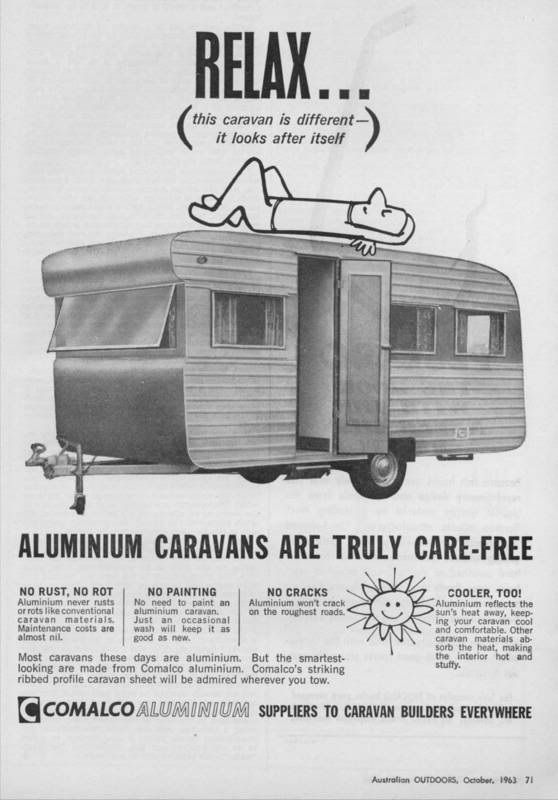
|
|
|
|
Post by Franklin1 on Nov 17, 2007 22:05:44 GMT 10
WATERPROOF PLYWOOD/BONDWOODUndated brochure for GIANT RESWOOD product:
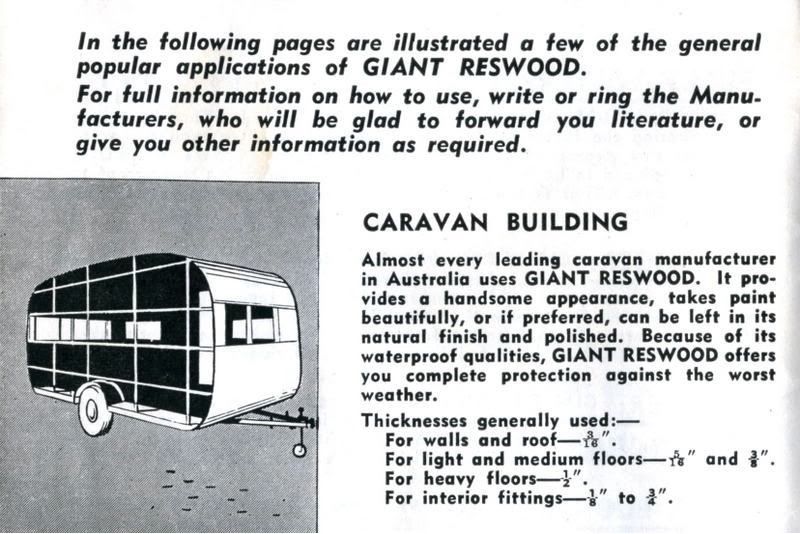 (source: forum member chippydave, 6 Aug 2007)
|
|
|
|
Post by Franklin1 on Nov 19, 2007 19:30:38 GMT 10
1960 advertisement from Motor Manual magazine: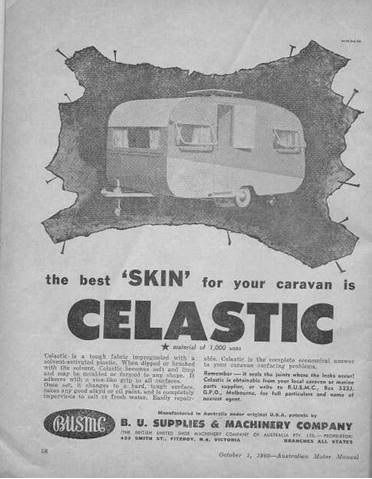 (source: posted by gristy, Jun 25, 2007)
|
|
|
|
Post by Franklin1 on Dec 19, 2007 21:49:41 GMT 10
ALUMINIUM WINDOWS
On Aug 8, 2007, lazza wrote (in response to a query): The windows in your van are Alfab brand and were used from 1966 until 1971 approx. We used them in our vans until early 1972 when wind-out windows became the norm.
|
|
|
|
Post by Franklin1 on Apr 14, 2008 21:11:42 GMT 10
1953 CARAVAN KITS ADVERTISEMENT:A list showing the retailers/manufacturers selling caravan kits... 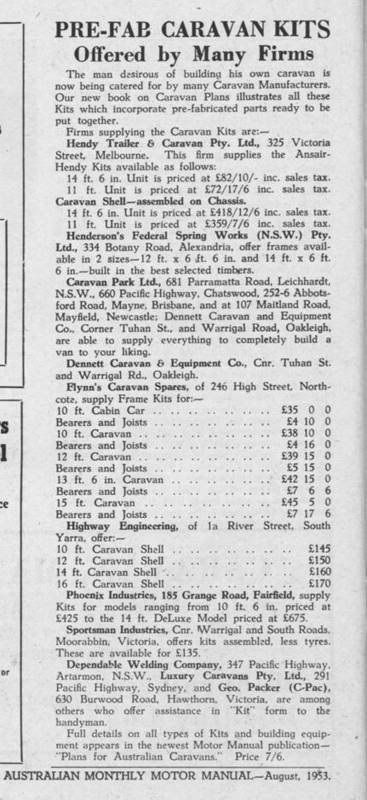 (source: Australian Monthly Motor Manual, August 1953, page 314.)
|
|
|
|
Post by Franklin1 on Apr 14, 2008 21:37:22 GMT 10
SHEET ALUMINIUM1950 advertisement: (source: Australian Monthly Motor Manual, February 1950, page 747.)
|
|
|
|
Post by Franklin1 on Apr 24, 2008 18:07:31 GMT 10
1953 advertisement for Stormseal sealant/caulking compound: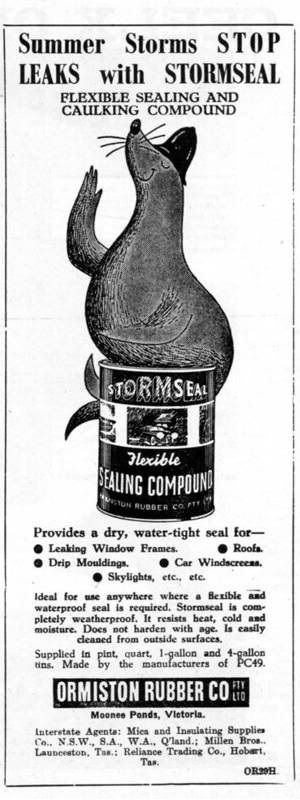 (source: Motor Manual magazine, February 1953, Page 751.)
|
|
|
|
Post by tinnie on Apr 24, 2008 23:08:26 GMT 10
Hi, I hate to correct Lazza, and maybe I'm not, they probably used Alfab windows from 1966. Two of my vans have Alfab windows, one I think is 1963 and the other definately is. Before that?? Cheers, Gristy  |
|
|
|
Post by cobber on Jun 10, 2008 16:28:17 GMT 10
The second advertisement here re-enforces the fact that Masonite Corporation was one of the companies who supplied plans for caravans to promote the use of their product in the construction of caravans. Masonite Corporation (Australia) Ltd (1938 - 1955) Online Sources Function: Forest or Timber Industries Location: Raymond Terrace, New South Wales, Australia Masonite Corporation (Australia) was the first true hardboard plant in Australia, and was established in 1938. In 1955 the business was reorganised and renamed as Masonite Holdings Limited. This add. from the 1938/39 edition of the "Australian Caravan Magazine and Log Manual" 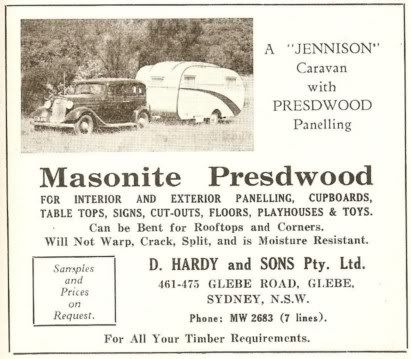 This Add. Came out of a 1948 book. 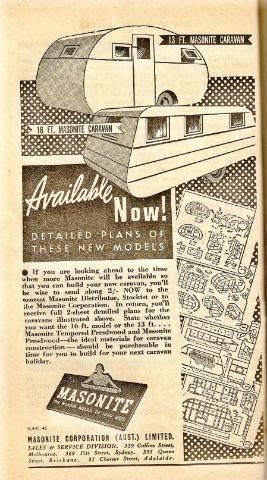 And here are the instructions on bending Masonite 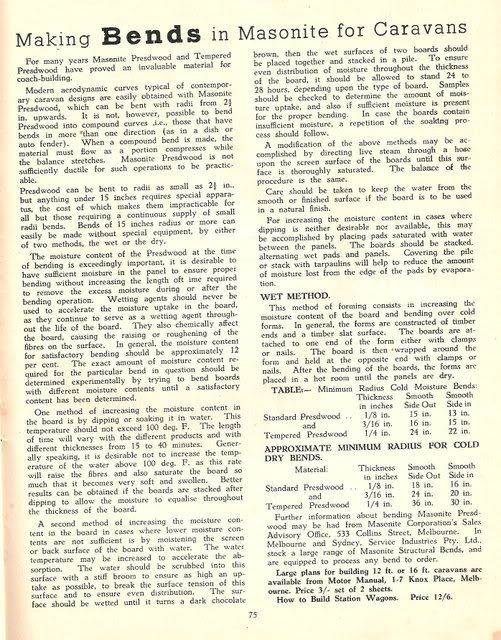 Although it is best known now as a material for indoor fittings, the company initially tried to promote it for exterior use as well. As a rival for fibrolite sheeting they marketed a special line, “Masonite Tempered Presdwood”. Despite their claim that this was more moisture resistant than timber it did not prove so in practice. Problems with water notwithstanding, demand for Masonite was strong, for interior finishing and especially for cupboards and cheap furniture. The most famous piece of Masonite was Rolf Harris’s “Wobble-board.” (From a Monash University site) Cobber. |
|
Deleted
Deleted Member
Posts: 0
|
Post by Deleted on Jun 10, 2008 20:15:04 GMT 10
Masonite Bluckys ( from Wodonga) TD that i bought home from Lockhart had a masonite roof , rear boot lid and front. It had 15" Morris Iris wheels on it and we guessedamated it was built in 1948 or very close / thereabouts. 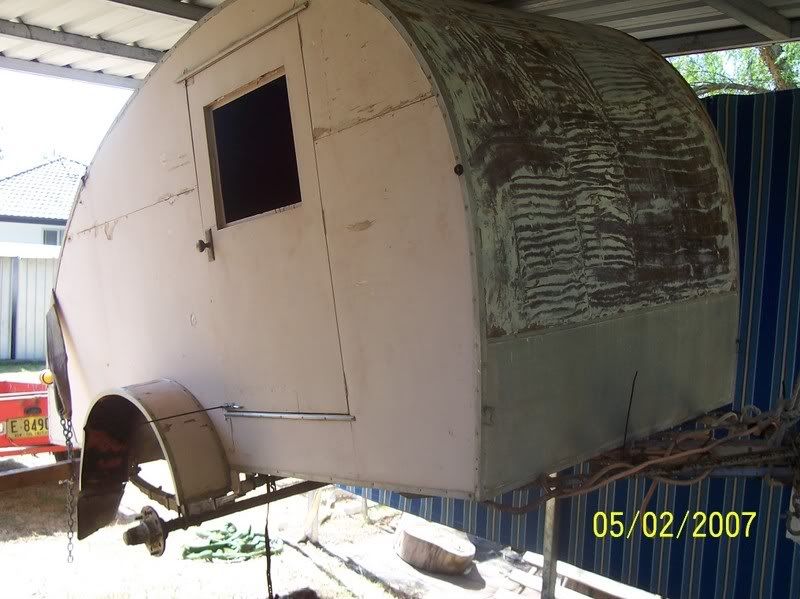 GR |
|
|
|
Post by Don Ricardo on Sept 16, 2008 22:03:42 GMT 10
|
|
|
|
Post by cobber on Sept 26, 2008 17:52:58 GMT 10
The weight of various caravan construction materials in 1951, the point being..... there was a lot of help & encouragement to build your own caravan in the 1950's. 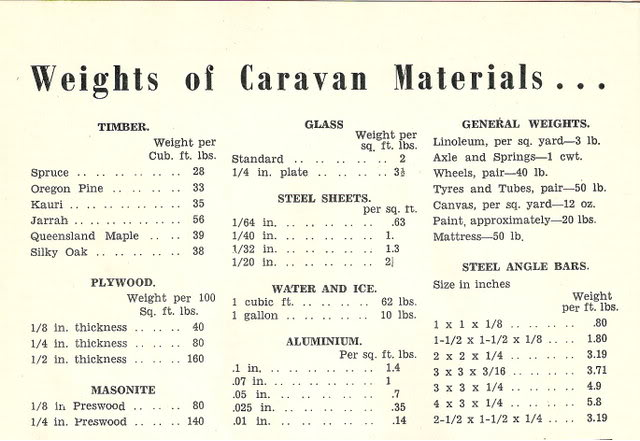 Cobber. |
|
|
|
Post by cobber on Oct 30, 2008 16:36:53 GMT 10
Reswood..... Rescote......Plasply...... Alumply All of them products from Ralph Symonds Pty Ltd. Some times life gets complicated. (By the way.... "Presdwood" is not a ply wood... it is "Masonite", see up the page a bit) The earliest reference to "Plasply" (which was a plastic coated "Reswood" is this add. from November 1948.  The earliest reference I have found for Reswood and Rescote is this one from August 1952 that indicates that Rescote was a fire retardant paint applied to Reswood. 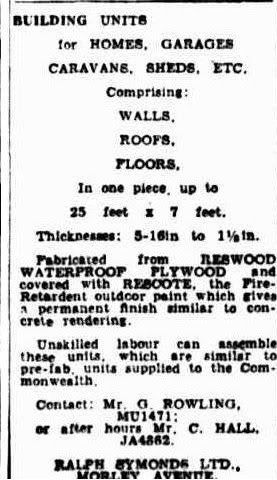 The following advertisements from 1959 / 62 seem to indicate that “Reswood” did finish up with a plastic coating but was still referred to as “Rescote”. The 1959 Add. 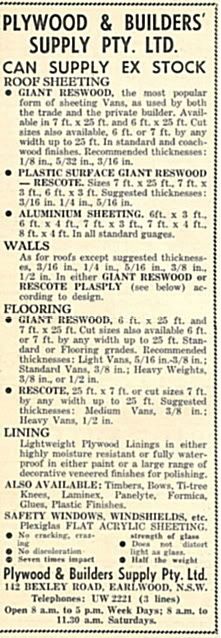 A 1962 Add. 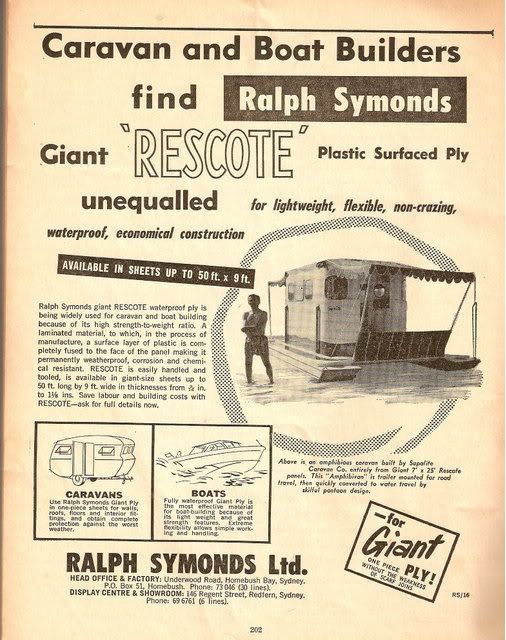 Here we have a sample of Ralph Symonds “Giant Reswood” as used on the van being restored by Carapark..... see photos HERE. On the edge of the ply the stencil says “GIANT Reswood ” then “25 ft one piece waterproof plywood”. This shows that "Reswood" was not coated with a plastic layer..... That was "Rescote" 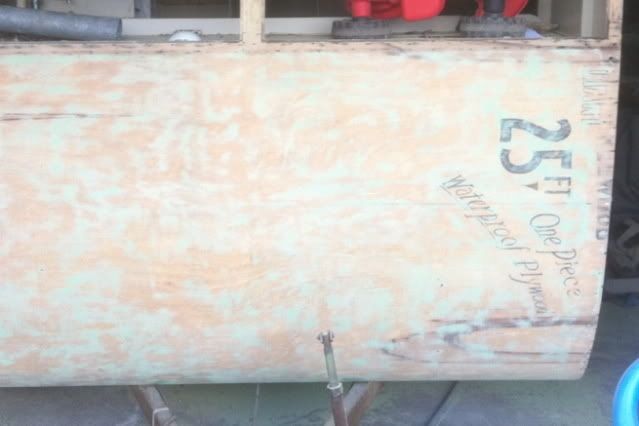 Cobber. |
|
|
|
Post by cobber on May 2, 2009 14:43:51 GMT 10
In the 1957 Caravan and Touring Manual they list some of the external materials available to cover caravans. 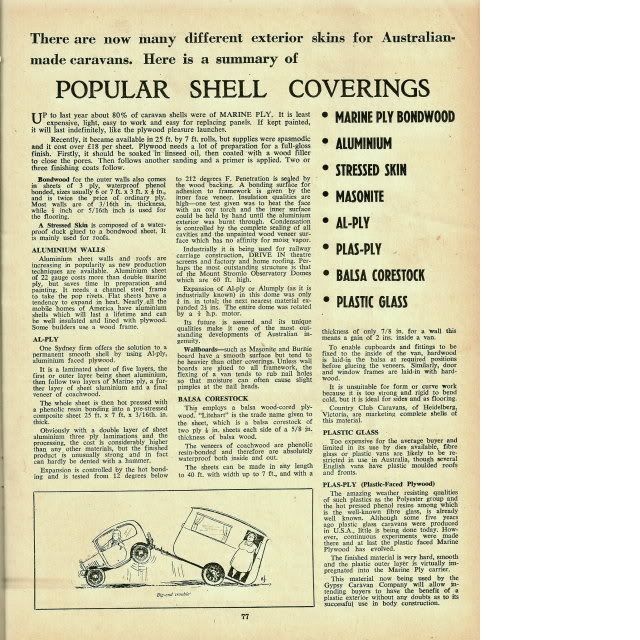 Then from the 1959 Caravan and Touring manual, showing some of the materials available to the industry... and the home builder at that time..... not much difference except for the reference to "Reswood" and "Plas-ply" 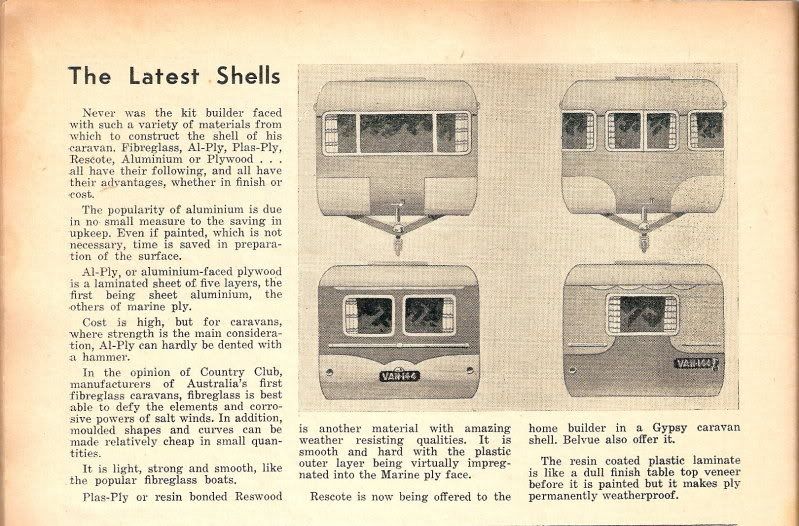 I recently found this 1959 advertisement for “Alumply” made by Ralph Symonds. I don't think we have heard of it being used on caravans but “Alply” or "Al-ply" is a name often associated with caravan construction. The 1955 description of Alply was posted by Geoff 'n Jude in the Gypsy Caravan thread in DHL and it was claimed to be exclusive to them. According to the Keith Winser Caravan and Touring Manuals it was not offered on Gypsy vans as an option in 1959 so it didn't last long. I doubt that “Alumply was ever used in the construction of caravans but............. you never know  . "Alumply"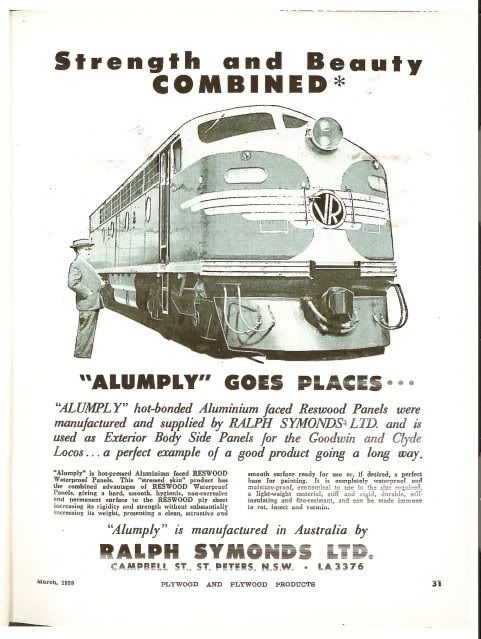 "Alply" "Alply"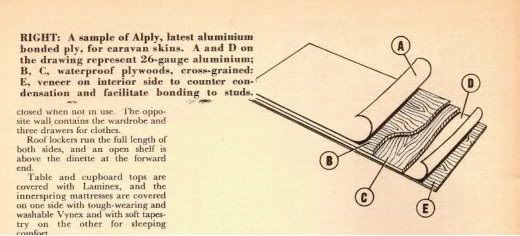 So..... it would appear that the resin impregnated plywood know as "Reswood" was not only used as it was but was also coated with plastic to become known as "Rescote" or "Plasply" or..... could have sheet aluminum bonded to it and be caller "Alumply", There is contradictory messages in the Adds. above that indicate that "Rescote" was either a fire retardant paint applied to "Reswood" or.... a plastic coating applied to "Reswood" Cobber. |
|
|
|
Post by Don Ricardo on May 20, 2009 22:10:06 GMT 10
Hi all, This article from the April 1954 Australian Motor Manual was posted by Firefighter on 17 May 2009:  It states that in the previous six months (ie presumably late 1953), the Jennison factory had changed over from bondwood exterior cladding to aluminium. The specifications of different cladding material from an article in 1951 provided by Cobber in Reply #12 on this thread lists aluminium and steel. Do we know when the first commercially produced caravans were produced with aluminium cladding? Does anybody know of any aluminium vans prior to 1953, or was Jennison the first to go in that direction? If memory serves me right, Carapark were producing steel clad caravans at least as early as 1947 as evidenced by Austin125's beautifully restored and preserved Carapark. Was Carapark the first to use steel cladding, and if so when did this start? Did anybody else use steel, or did they all wait for aluminium to come along? Some of these questions have probably been answered before on the forum, but if so I haven't seen the answers. Don Ricardo |
|
|
|
Post by Jennison on May 22, 2009 3:32:20 GMT 10
Funny thing with that article, Jennisons "experiment?" with gal sheeting as cladding, ie my 53 pathfinder, must have been a one off (I presume due to weight problems- she comes in at 1100kg - 14 foot bondwood p/f is around 850kg @125lb per foot according to their sales promo)
Just reading that fine print in the article , it says that - "jennison built their first aluminium model pathfinder in 1949 and that after 4 1/2 years in the weather without maintenance no deterioration has occurred to the panels" This was when my grandfather was still alive and running the business so they were apparently experimenting with aluminium prior to 1950.
Jennison
|
|
|
|
Post by Franklin1 on May 24, 2009 22:39:01 GMT 10
1955 advertisement: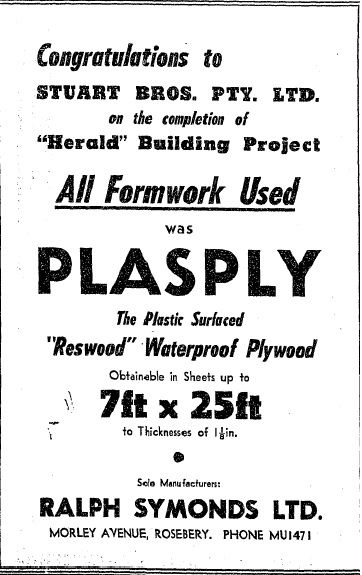 ----------------------------------- 1956 advertisement: ------------------------------------ 1959 advertisement: ------------------------------------ 1960 advertisement: ------------------------------------ 1961 advertisement: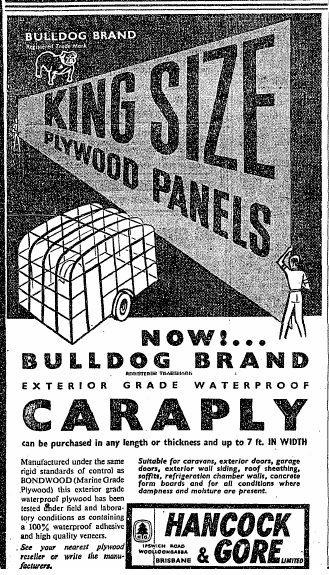 ------------------------------------- 1966 advertisement: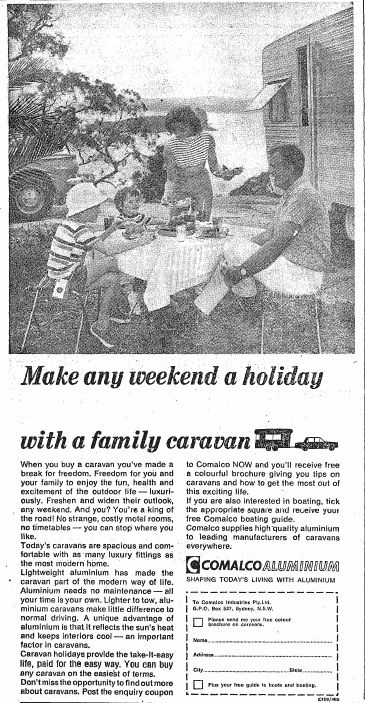
|
|
|
|
Post by cobber on Feb 11, 2013 10:47:58 GMT 10
CANE-ITE (Caneite) was a popular material for use in the construction of roofs on caravans built during the 1940s & '50s, mainly those vans built in South Australia, but not exclusively. It is a soft board made from bagasse which are the fibres left over from sugar cane after crushing. Why SA adopted Cane-ite so widely is not known but it did have the ability to bend in two directions simultaneously--- front to back and side to side, giving a very attractive appearance. It had very good insulating properties so that often a "ceiling" was not required. However it was necessary to protect the exterior and this was usually done by covering it with "doped canvas / Calico" ... Roadmaster vans used fibreglass. On vans with plywood roofs Cane-ite was sometimes used as a ceiling, in Don caravans for instance. To see examples of the type of curves possible go to the Roadmaster and Rowvan threads in DHLJune 1938 first Cane-ite add. announcing the manufacture of it in Australia by the Colonial Sugar Refinery (CSR) 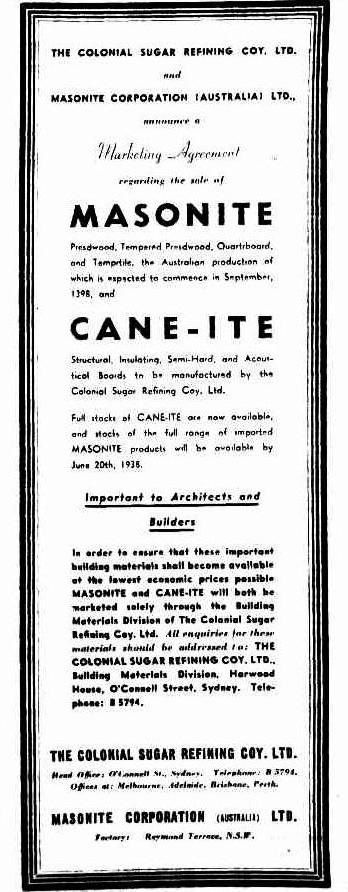 at Pyrmont in NSW 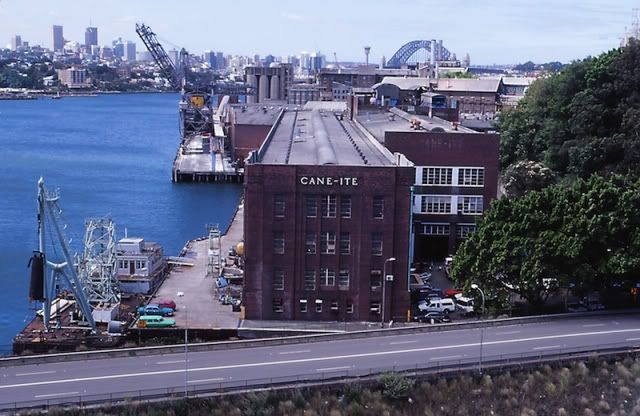 Don't get excited by the photo because it is not made there now, however..... Gunnersens advertise the availability of Softboard" which is a similar product and is manufactured in South Africa these days. For other suppliers go to the Restoration Parts Suppliers ThreadCobber. |
|
|
|
Post by seeshell on Feb 11, 2013 12:57:53 GMT 10
Hi All Maybe it's my background in new product design, but I'm really interested to know what came first: the cane-ite or the roof design in SA. Does anyone know when canite was first produced? Or when the first dual cambered roofs were produced? It seems, considering the available products of the day, the double camber is most easily achieved with the soft board or cane-ite. Masonite beds unidirectionally, and only very thin ply works in more than one direction without being steamed. One assumes they were going for the simplest kind of manufacturing, and didn't intend to steam wood to bend it to their purposes - in the too hard basket for day to day building, especially something as large as a roof. With that in mind, it's hard to imagine that designers decided on a double camber roof (with all the attendant issues!) before examining what materials were available to them. If that's so, you'd have to argue that they designed the roofs with a product in mind. If they did start with a product and then move to a design, it might well explain the high take up of a product that is not local in SA; it manufactured out of state in NSW, the byproduct of a industry even further away in QLD. And a very active sales rep? Some other business link? But it does nothing to explain why they did the double cambers to begin with! And why this design choice was important enough to choose to ship in a non-local product. I'm making an assumption at present the cane-ite predated the design. I've nothing to back up my thoughts here - so I'm throwing them open to others to dissect. Discuss!  Seeshell |
|
|
|
Post by Rattles on Feb 11, 2013 13:57:36 GMT 10
My Parents home that I spent my early years had a filled in veranda that had a canite ceiling and the house was built around 1946-47 and I had a 1965 Viscount Ambassador that also had canite as an internal roof lining and from memory it was a CSR product.
Rattles
|
|
|
|
Post by cobber on Feb 11, 2013 15:41:11 GMT 10
Seeshell/Rattles, Like the advertisement in my post says  ...... CSR were announcing the availability of Cane-ite in 1938 I'd guess that first there was the product, then a few van builders in SA thought they could make some distinctive unique looking vans by using the stuff...... and they did. Too simple  Cobber |
|
|
|
Post by DC3Td on Feb 11, 2013 15:56:44 GMT 10
|
|
|
|
Post by seeshell on Feb 11, 2013 17:32:40 GMT 10
Hi Cobber
I agree - oops! missed that date in the add (my what sharp eyes you have Mr. Wolf!).
I wonder why the double camber - it wouldn't have anything to do with climate would it? Or was it just something people/designers copied?
Cheers
Seeshell
|
|
|
|
Post by Don Ricardo on Feb 12, 2013 22:21:03 GMT 10
Hi Seeshell,
My theory - and that is all that it is - is that for some reason, South Australian caravan builders tended to follow the design cues provided by English caravan manufacturers for longer than in other states (that's not intended as a criticism, just an observation). In truth there was probably one or two South Oz manufacturers who took their cues from England and the other South Oz builders followed their lead.
Some English builders adopted the double cambered roof in the early 30's and also covered their rooves in canvas. South Australian builders seemed to begin to "double camber" (can that be a verb?) their rooves in the mid-30's (although not to the extent that say Rowvan, Adventurer and Roadmaster did in the 50's), and of course very commonly covered their rooves in canvas. In contrast these features were uncommon, even rare, in other states.
Given that South Australian builders started to double camber their rooves in the mid-30's - apparently before caneite was released in 1938 - and English builders were double cambering their rooves even before that, my guess is that the style preceded caneite, not the other way around.
Maybe the double camber style began and when caneite was introduced, van builders found it very suitable for their use and quickly adopted it?
That leaves the question of what South Australian (and English) van builders put under the canvas before they had caneite...and I have no idea!
Just to add to the story of caneite, Don lined the ceilings of its leadlight window vans with caneite because of its insulating properties, even though the rooves are not double cambered. (Not sure what they did before 1938 - when I can lay my hands on a pre-1938 Don, I'll tell you! ;D ;D ;D) Quite a few other non-South Oz manufacturers also used caneite in a similar fashion. (I see Cobber has already referred to this.)
As Rattles has commented, caneite was a very common internal building material pre and post-WWII. My bedroom as a child (in a not cheap house) had caneite walls and ceiling. Given that building materials were pretty scarce in the years following the war, maybe caneite was more easily procurable for some reason, or maybe it was seen as the miracle product of its day?
Don Ricardo
|
|